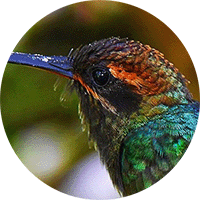White-whiskered Hermit
The White-whiskered Hermit (Phaethornis yaruqui) Read in Spanish
Appearance: The White-whiskered Hermit is a medium-sized hummingbird with distinctive features. It has a white or light-colored supercilium (eyebrow) and long, white or buff-colored malar stripes (whiskers) on its cheeks, giving it its name. The upperparts of the bird are typically green, and the underparts may vary from buffy to cinnamon in color. These birds have a long, slightly curved bill adapted for feeding on nectar from flowers and a dark tail.
Habitat: White-whiskered Hermits are commonly found in humid forests, including montane forests, cloud forests, and forest edges. They prefer habitats with dense vegetation and an abundance of flowering plants that provide a nectar food source. These hummingbirds may also occur in secondary growth, plantations, and gardens near forested areas.
Behavior: White-whiskered Hermits display hummingbird behaviors like feeding on nectar from flowers using their specialized bills. They are agile fliers with the ability to hover and access nectar from a variety of flower species. These birds may also supplement their diet with small insects and spiders for protein.
Breeding: The breeding behavior of the White-whiskered Hermit involves courtship displays by males to attract females. Nests are cup-shaped and constructed using plant fibers, moss, and spider silk, positioned on tree branches or vines. Female White-whiskered Hermits incubate the eggs and care for the young, with both parents participating in feeding and raising the chicks.
Conservation Status: The White-whiskered Hermit is categorized as "Least Concern" by the International Union for Conservation of Nature (IUCN).
Distribution
The White-whiskered Hermit (Phaethornis yaruqui) is primarily found in specific regions of Colombia, particularly in areas within the western part of the country. These regions include parts of the Andean mountain range and its foothills, as well as cloud forests and tropical forests characterized by high levels of biodiversity. The White-whiskered Hermit is known to inhabit forested areas with dense vegetation, where it can feed on nectar from flowers and insects.
Taxonomy
The White-whiskered Hermit (Phaethornis yaruqui)
- Kingdom: Animalia
- Phylum: Chordata
- Class: Aves (Birds)
- Order: Caprimulgiformes
- Family: Trochilidae
- Genus: Phaethornis
- Species: Phaethornis yaruqui
Vocalization
The White-whiskered Hermit (Phaethornis yaruqui)
- Chattering and Chirping Sounds: White-whiskered Hermits produce chattering and chirping sounds as a form of communication within their social groups. These sounds can vary in intensity and pitch, depending on the context of the communication.
- High-Pitched Whistles: They may emit high-pitched whistles, particularly during territorial disputes or encounters with rival individuals. These whistles can serve as warnings or signals to establish boundaries within their habitat.
- Buzzing Wing Sounds: Like other hummingbirds, the White-whiskered Hermit creates a buzzing sound with its wings during flight. This sound can be part of their vocal display and is a characteristic feature of their presence in their habitat.
- Calls and Vocalizations: The White-whiskered Hermit has specific calls and vocalizations that serve different purposes, such as signaling alarm, coordinating with other individuals, or attracting potential mates during courtship displays.





